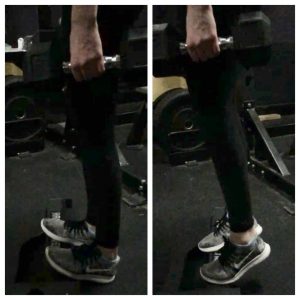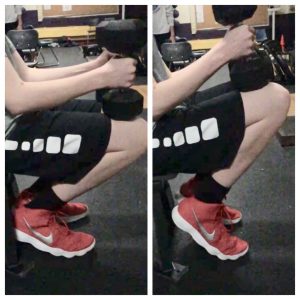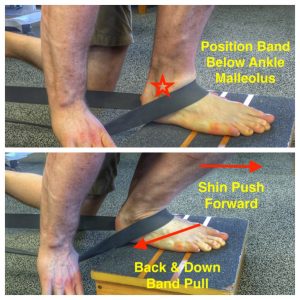Lower Leg Training Options
Recently, there has been a movement in the athletic preparation community to finally acknowledge that yes, you can in fact train your lower leg (calf complex and foot). For years the common thought was that if you run and jump on the field or court, somehow that “got” your lower limbs enough to warrant not touching your calf and foot within the confines of the weight room.Thankfully, some folks got around to asking why this was. Invariably, no one had a real legitimate answer and here we are, it’s cool to train that body part again. And for good reason. The foot, ankle, and calf, are extremely important in terms of setting your body up biomechanically for success (example- the knee only does what the foot can control). Squatting, running, jumping, and cutting are all made more robust and effective with a lower limb that does its job. Check out this video explaining how your lower leg can totally transform how your squat looks and feels.
In addition to the performance piece, we can also look at the injury prevention side of the coin. Foot and ankle sprains are still plaguing athletes in multiple sports throughout the USA. An estimated 10-30% of all sports related injuries are of the ankle sprain variety. While that’s a substantial figure, there is hope in combating that number. Primarily, a strength training program that focuses on making the muscles, tendons, and ligaments of the feet and ankles stronger and less yielding to outside forces.
While not exhaustive, here is a quick list of exercises/movements that you can throw in to your training protocol today.
Standing Calf Raise
A classic that can be done almost anywhere and anytime. In the gym, on some stairs, one legged, two legged, fast, slow, isometrically…there are a ton of variations to this basic movement. The shin stays vertical in this application with the gastroc being the primary muscle used in its completion. This is of importance to athletes that maximally run, as your shin is more vertical when sprinting and jumping. If you have mastered this exercise with your own body weight, it can be made more difficult by adding weight, raising the surface, or putting less of the foot on the elevated surface.
 Seated Calf Raise
Seated Calf Raise
Often forgotten, but of extreme value for athletes that need to accelerate, the seated calf raise works the other muscle in the calf (soleus). If you are lucky enough to have a seated calf raise machine in your gym then three cheers to you. If not, you can still perform this exercise, though you might have to pull a MacGyver to make it work. A lot of times I will have an athlete I train sit on a bench or box and drive their knees forward over their toes. From there, we will either load a set of dumbbells or a barbell on the knee and elevate the heel up and down, stretching and strengthening the ankle in one fell swoop.
 Big Toe Extend To Flex
Big Toe Extend To Flex
In addition to your ankles, getting your toes to move well is another game changer in making your lower leg more resilient. Big toe extension is particularly important in setting up the ankle to move better. Depending on the literature you read, some prescribe that you need between 50-70 degrees of big toe extension. Lacking this ability won’t necessarily turn your body into a sea of injuries, but improving the movement quality through the feet is still a key component in creating awesome athletes. This video demonstrates how to perform this tough little number. I initially struggled mightily when attempting this drill, but have since improved by simply continuing to practice it. Crazy how that works eh?
Banded Ankle Distractions
This is a great complementary exercise to the seated calf raise. All you need is a band and a place to elevate your foot slightly. The point of the band is to aid in how the joints slide across each other. The band here pulls the talus bone backwards as the shin moves forward. Check out this picture sequence from the folks at Squat University to fully grasp how this setup works.
 Roll Bottom of Foot/ Train Barefoot
Roll Bottom of Foot/ Train Barefoot
There are approximately 100,000-200,000 exteroceptors (nerve endings that gather information from the outside world) on the bottom of your feet. With most of our time spent locked up in shoes, these nerve endings often become extremely sensitive to the outside world. A post from the Barefoot Professor explains more. The professor writes,
“The perception of pain takes place in the brain, not the body. Most of us have been told to wear shoes since early childhood; consequently, our brains are unaccustomed to receiving tactile information from the feet. On those rare occasions when we do walk barefoot, our brains receive ‘sensory overload’ and interpret the strange sensations as painful. Deaf persons who receive their hearing through cochlear implants report their first sounds as painful for the same reason. However, once the brain figures out that the new stimulus is not harmful, the pain subsides. Indeed, what was once considered painful is now re-interpreted as pleasure.”
Get out of your shoes and show your brain that it’s okay to strengthen and expose the soles to different tactile information. Once the gray matter starts to see that the feet can handle more than what we usually give it, then it’s amazing to see how the rest of the body will follow.
Great athletes have strong feet and ankles. Use these exercises to move better, feel better, and step your game up a notch on the field of play.


